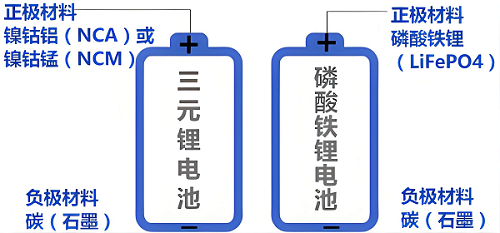Ternary lithium-ion batteries and lithium iron phosphate batteries are currently two widely used types of lithium-ion batteries. They each have some advantages and disadvantages, and the choice can be made according to specific application scenarios.

Ternary lithium batteries generally refer to ternary polymer lithium batteries, which are lithium batteries with ternary cathode materials such as lithium nickel cobalt manganate (Li(NiCoMn)O2) or lithium nickel cobalt aluminate used as the cathode material.
Advantages of ternary lithium-ion batteries:
1. High energy density: Ternary lithium batteries have a relatively high energy density, which can provide a high energy storage capacity. They are suitable for applications with high requirements for energy density, such as electric vehicles.
2. Long charge-discharge cycle life: Ternary lithium batteries have a good cycle life and can undergo a large number of charge-discharge cycles, reaching thousands of times or more. They are suitable for scenarios with long-term use.
3. Fast charging speed: Compared with other types of lithium-ion batteries, ternary lithium batteries have a faster charging speed.
Disadvantages of ternary lithium-ion batteries:
1. High cost: Compared with lithium iron phosphate batteries, the manufacturing cost of ternary lithium batteries is higher.
2. Poor safety: Under extreme conditions, such as in a high-temperature environment, the safety of ternary lithium batteries is relatively poor.
3. Larger size and weight: Ternary lithium batteries have a high energy density, but for the same energy capacity, their size and weight are usually larger than those of lithium iron phosphate batteries.
Lithium iron phosphate batteries are a type of lithium-ion battery that uses lithium iron phosphate (LiFePO4) as the cathode material and carbon as the anode material.
Advantages of lithium iron phosphate batteries:
1. Good safety: Lithium iron phosphate batteries have relatively high safety in a high-temperature environment and have good thermal stability.
2. Low cost: Compared with ternary lithium batteries, the manufacturing cost of lithium iron phosphate batteries is lower.
3. Environmentally friendly: Lithium iron phosphate batteries have a lower material cost and do not contain heavy metals, making them environmentally friendly batteries.
Disadvantages of lithium iron phosphate batteries:
1. Relatively low energy density: Lithium iron phosphate batteries have a low energy density, and the weight of batteries with the same capacity is also relatively large.
2. Slow charging speed: Compared with ternary lithium batteries, the charging speed of lithium iron phosphate batteries is slower.
3. Short cycle life: Compared with ternary lithium batteries, the charge-discharge cycle life of lithium iron phosphate batteries is shorter.
When choosing between ternary lithium-ion batteries and lithium iron phosphate batteries, it is necessary to make a trade-off and selection according to specific application requirements to meet different requirements for energy density, safety, cost, and cycle life.



